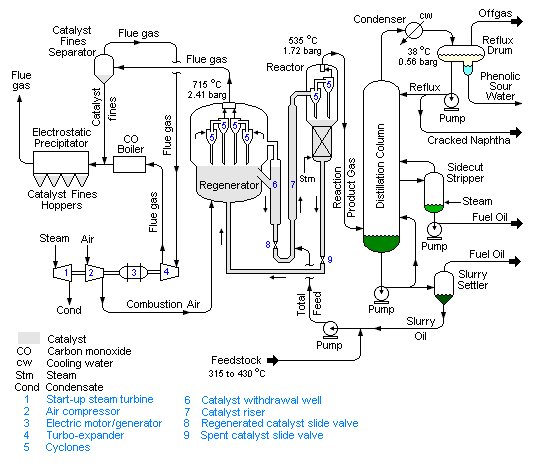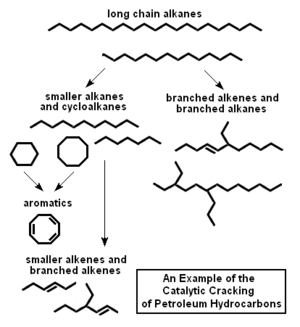User:Milton Beychok/Sandbox: Difference between revisions
imported>Milton Beychok No edit summary |
imported>Milton Beychok No edit summary |
||
| Line 1: | Line 1: | ||
[[Image:FCC.jpg|right|thumb|250px|{{#ifexist:Template:FCC.jpg/credit|{{FCC.jpg/credit}}<br/>|}}Fluid Catalytic Cracker (from left to right: Distillation column, Reactor and Regenerator)]] | [[Image:FCC.jpg|right|thumb|250px|{{#ifexist:Template:FCC.jpg/credit|{{FCC.jpg/credit}}<br/>|}}Fluid Catalytic Cracker (from left to right: Distillation column, Reactor and Regenerator)]] | ||
The '''fluid catalytic cracker''' (FCC) is the most important conversion process unit used in petroleum refineries. It is widely used to convert the high-boiling hydrocarbon fuel oils in petroleum crude oils to more valuable gasoline, olefinic gases and other products.<ref name=Gary>{{cite book|author=James H. Gary and Glenn E. Handwerk|title=Petroleum Refining: Technology and Economics|edition=4th Edition|publisher=CRC Press|year=2001|id=ISBN 0-8247-0482-7}}</ref><ref name=Speight>{{cite book|author=James. G. Speight|title=The Chemistry and Technology of Petroleum|edition=4th Edition|publisher=CRC Press|year=2006|id=ISBN 0-8493-9067-2}}</ref><ref name=Reza>{{cite book|author=Reza Sadeghbeigi|title=Fluid Catalytic Cracking Handbook|edition=2nd Edition|publisher=Gulf Publishing|year=2000|id=0-88415-289-8}}</ref> The feedstock to an FCC is usually that portion of the crude oil that has an initial boiling point of 330 °C or higher at atmospheric pressure. | The '''fluid catalytic cracker''' (FCC) is the most important conversion process unit used in petroleum refineries. It is widely used to convert the high-boiling hydrocarbon fuel oils in petroleum crude oils to more valuable gasoline, olefinic gases and other products.<ref name=Gary>{{cite book|author=James H. Gary and Glenn E. Handwerk|title=Petroleum Refining: Technology and Economics|edition=4th Edition|publisher=CRC Press|year=2001|id=ISBN 0-8247-0482-7}}</ref><ref name=Speight>{{cite book|author=James. G. Speight|title=The Chemistry and Technology of Petroleum|edition=4th Edition|publisher=CRC Press|year=2006|id=ISBN 0-8493-9067-2}}</ref><ref name=Reza>{{cite book|author=Reza Sadeghbeigi|title=Fluid Catalytic Cracking Handbook|edition=2nd Edition|publisher=Gulf Publishing|year=2000|id=0-88415-289-8}}</ref> The feedstock to an FCC is usually that portion of the crude oil that has an initial boiling point of 330 °C or higher at atmospheric pressure. The FCC process cracks the long-chain molecules of the high-boiling hydrocarbon liquids into much shorter molecules by vaporizing and heating them to a high temperature at moderate pressures while contacting them with a powdered catalyst. | ||
In effect, refineries use fluid catalytic cracking to correct the imbalance between the market demand for gasoline and crude oil distillation that produces an excess of heavy, high boiling range products. | In effect, refineries use fluid catalytic cracking to correct the imbalance between the market demand for gasoline and crude oil distillation that produces an excess of heavy, high boiling range products. | ||
Revision as of 23:21, 23 April 2008
The fluid catalytic cracker (FCC) is the most important conversion process unit used in petroleum refineries. It is widely used to convert the high-boiling hydrocarbon fuel oils in petroleum crude oils to more valuable gasoline, olefinic gases and other products.[1][2][3] The feedstock to an FCC is usually that portion of the crude oil that has an initial boiling point of 330 °C or higher at atmospheric pressure. The FCC process cracks the long-chain molecules of the high-boiling hydrocarbon liquids into much shorter molecules by vaporizing and heating them to a high temperature at moderate pressures while contacting them with a powdered catalyst.
In effect, refineries use fluid catalytic cracking to correct the imbalance between the market demand for gasoline and crude oil distillation that produces an excess of heavy, high boiling range products.
As of 2006, FCC units were in operation at 400 petroleum refineries worldwide and about one-third of the crude oil refined in those refineries is processed in an FCC to produce high-octane gasoline, diesel oil and fuel oil.[2][4]
The processing capacity of current FCC unit designs ranges from about 2,400 to 19, 900 m3/day of feedstock. During 2007, the FCC units in the United States processed an average of 834,300 m3/day of feedstock.[5]
Flow diagram and process description
Chemistry
Catalysts
History
References
- ↑ James H. Gary and Glenn E. Handwerk (2001). Petroleum Refining: Technology and Economics, 4th Edition. CRC Press. ISBN 0-8247-0482-7.
- ↑ 2.0 2.1 James. G. Speight (2006). The Chemistry and Technology of Petroleum, 4th Edition. CRC Press. ISBN 0-8493-9067-2.
- ↑ Reza Sadeghbeigi (2000). Fluid Catalytic Cracking Handbook, 2nd Edition. Gulf Publishing. 0-88415-289-8.
- ↑ David S.J. Jones and Peter P.Pujado (Editors) (2006). Handbook of Petroleum Processing, First Edition. Springer. ISBN 1-4020-2819-9.
- ↑ U.S. Downstream Processing of Fresh Feed Input by Catalytic Cracking Units (Energy Information Administration, U.S. Dept. of Energy)


